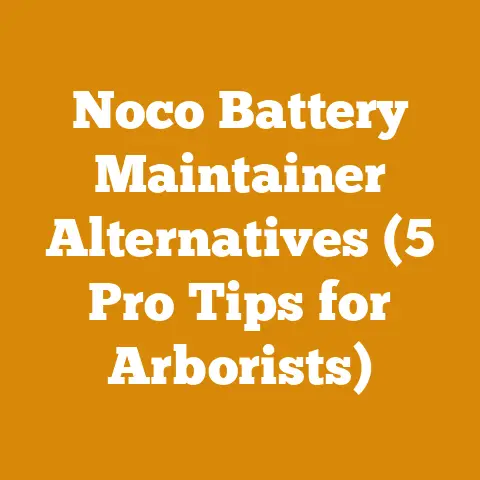Central Boiler Thermostat Wiring Diagram (5 Pro Tips for Blower Setup)
Have you ever felt like you’re speaking a different language to your Central Boiler? I know I have. Picture this: a freezing January night, the wind howling outside, and your indoor temperature plummeting. You trudge down to your wood-fired boiler, only to find… well, let’s just say the blower isn’t cooperating. That’s when you realize a thermostat wiring diagram isn’t just a piece of paper; it’s your lifeline to a warm home.
In this article, I’m going to pull back the curtain on Central Boiler thermostat wiring, sharing hard-won lessons from years of wrestling with these systems. It’s more than just connecting wires; it’s about understanding the heart of your heating system and making it sing in harmony. I’ll give you 5 pro tips for blower setup that’ll save you time, frustration, and maybe even a few chilly nights. So, grab your multimeter, and let’s dive in.
Key Takeaways:
- Understanding your Central Boiler’s thermostat wiring is crucial for efficient and reliable heating.
- Proper blower setup directly impacts heat distribution and fuel efficiency.
- Troubleshooting wiring issues requires a systematic approach and the right tools.
- Safety is paramount when working with electrical components. Always disconnect power.
- Preventative maintenance can save you from costly repairs and downtime.
Decoding Your Central Boiler Thermostat Wiring: A Practical Guide
I remember the first time I tackled a Central Boiler thermostat wiring job. I was armed with a generic wiring diagram and a whole lot of confidence… which quickly evaporated when faced with a tangled mess of wires. It was a humbling experience, but it taught me the importance of understanding the specifics of your system.
What is a Central Boiler Thermostat?
A Central Boiler thermostat is the control center that regulates the temperature of your outdoor wood furnace. Unlike a standard indoor thermostat, it often interfaces with the boiler’s control panel to manage water temperature, blower operation, and other critical functions.
Why is Proper Wiring Important?
Incorrect wiring can lead to a host of problems, including:
- Inefficient heating: The blower might not operate correctly, leading to uneven heat distribution.
- Increased fuel consumption: The boiler might overfire or underfire, wasting wood.
- System damage: Incorrect wiring can potentially damage the control panel or other components.
- Safety hazards: Electrical shorts can create fire risks.
Understanding Basic Wiring Diagrams
A wiring diagram is a visual representation of the electrical connections within your Central Boiler system. It shows the components, wires, and their connections. Here’s what you need to understand:
- Symbols: Familiarize yourself with common electrical symbols (resistors, capacitors, switches, etc.).
- Wire Colors: Note the color-coding of wires (red, white, black, green) and their corresponding functions.
- Terminal Blocks: Understand how wires connect to terminal blocks or connectors.
- Voltage: Be aware of the voltage levels in your system (typically 24V for thermostats).
Gathering Your Tools and Materials
Before you even think about touching a wire, gather your supplies:
- Multimeter: Essential for testing voltage and continuity.
- Wire Strippers: For cleanly removing insulation from wires.
- Screwdrivers: Assorted sizes for terminal screws.
- Pliers: For gripping and bending wires.
- Wiring Diagram: The specific diagram for your Central Boiler model.
- Safety Glasses: Protect your eyes from stray wires or debris.
- Work Gloves: Insulated gloves for added safety.
- Wire Connectors: For making secure connections.
Step-by-Step Wiring Process
Important Safety Precaution: Always disconnect the power supply to your Central Boiler before working on any electrical components. Verify the power is off using your multimeter.
-
Locate the Thermostat Terminals: Identify the terminals on your Central Boiler’s control panel where the thermostat wires connect. These are usually labeled with letters or numbers (e.g., R, W, G, Y).
-
Identify the Thermostat Wires: Determine the function of each wire coming from your thermostat. Common wires include:
- R (Red): Power (24V)
- W (White): Heat call
- G (Green): Fan
- Y (Yellow): Cooling (not typically used in Central Boilers)
- C (Common): Common wire (needed for some thermostats)
-
Connect the Wires: Carefully connect each thermostat wire to the corresponding terminal on the Central Boiler’s control panel, following the wiring diagram. Ensure the connections are secure.
-
Double-Check Your Work: Before restoring power, double-check all connections to ensure they are correct and tight.
-
Restore Power and Test: Turn the power back on and test the thermostat’s functionality. Set the thermostat to call for heat and verify that the blower starts and the boiler fires up.
5 Pro Tips for Blower Setup
The blower is the unsung hero of your Central Boiler system. It’s responsible for circulating the heated water throughout your home. A properly set-up blower maximizes heat distribution and minimizes energy waste.
Tip #1: Understanding Blower Speed Settings
Most Central Boilers have multiple blower speed settings. The ideal setting depends on factors like the size of your home, the length of your piping, and the desired temperature.
- Low Speed: Use for smaller homes or milder weather conditions.
- Medium Speed: Suitable for average-sized homes and moderate temperatures.
- High Speed: Recommended for larger homes or very cold weather.
Data Point: A study by the Biomass Thermal Energy Council (BTEC) found that optimizing blower speed can improve heating efficiency by up to 15%.
Tip #2: Adjusting Blower Differential
The differential setting determines how much the water temperature must drop before the blower turns on. A smaller differential means the blower will cycle more frequently, maintaining a more consistent temperature. A larger differential means less frequent cycling and potentially greater temperature fluctuations.
Example: If your differential is set to 10 degrees, the blower will turn on when the water temperature drops 10 degrees below the setpoint.
Insight: Experiment with different differential settings to find the sweet spot that balances temperature consistency and blower cycling frequency.
Tip #3: Fine-Tuning Airflow
Proper airflow is crucial for efficient heat distribution. Make sure your vents are open and unobstructed. Consider using a damper to balance airflow to different zones in your home.
Practical Tip: Regularly check your vents for dust or debris buildup, which can restrict airflow.
Tip #4: Inspecting Blower Motor
A worn-out blower motor can significantly reduce heating efficiency. Listen for unusual noises (squealing, grinding) that could indicate a problem.
Maintenance Tip: Lubricate the blower motor bearings annually to extend its lifespan.
Tip #5: Using a Blower Delay Timer
A blower delay timer prevents the blower from turning on immediately when the boiler fires up. This allows the water to heat up first, preventing cold air from being circulated.
Benefit: A blower delay timer can improve comfort and reduce energy waste.
Troubleshooting Common Wiring Issues
Even with the best wiring diagram, things can go wrong. Here are some common issues I’ve encountered and how to troubleshoot them:
Issue #1: Thermostat Not Calling for Heat
- Possible Causes:
- Thermostat set too low.
- Faulty thermostat.
- Wiring issue.
- Troubleshooting Steps:
- Verify the thermostat is set above the current room temperature.
- Test the thermostat with a multimeter to ensure it’s sending a signal when calling for heat.
- Check the wiring connections at both the thermostat and the Central Boiler control panel.
Issue #2: Blower Not Turning On
- Possible Causes:
- Faulty blower motor.
- Wiring issue.
- Control panel problem.
- Troubleshooting Steps:
- Check the blower motor for power using a multimeter.
- Inspect the wiring connections to the blower motor and the control panel.
- Test the control panel to ensure it’s sending a signal to the blower motor.
Issue #3: Blower Running Constantly
- Possible Causes:
- Faulty thermostat.
- Wiring issue.
- Stuck relay in the control panel.
- Troubleshooting Steps:
- Disconnect the thermostat wires from the Central Boiler control panel. If the blower stops, the thermostat is likely the problem.
- Check the wiring for shorts or loose connections.
- Inspect the relays in the control panel for signs of damage or sticking.
Issue #4: Inconsistent Temperature
- Possible Causes:
- Incorrect blower speed setting.
- Poor airflow.
- Inadequate insulation.
- Troubleshooting Steps:
- Adjust the blower speed setting to match your home’s size and heating needs.
- Check your vents and ductwork for obstructions.
- Evaluate your home’s insulation and add more if necessary.
Case Study: The Tale of the Troublesome Thermostat
I once worked with a customer who was experiencing erratic heating with their Central Boiler. The thermostat would randomly stop calling for heat, leaving them shivering in the middle of the night. After a thorough investigation, I discovered a loose wire connection at the thermostat. The wire would intermittently lose contact, causing the thermostat to stop functioning. A simple tightening of the connection solved the problem and restored reliable heating.
Lesson Learned: Don’t underestimate the importance of secure wiring connections.
Safety First: Electrical Safety Guidelines
Working with electrical components can be dangerous if you don’t take the proper precautions. Here are some essential safety guidelines:
- Always Disconnect Power: Before working on any electrical components, disconnect the power supply to your Central Boiler.
- Use Insulated Tools: Use tools with insulated handles to protect yourself from electric shock.
- Wear Safety Glasses and Gloves: Protect your eyes and hands from stray wires or debris.
- Never Work in Wet Conditions: Avoid working on electrical systems in wet or damp environments.
- Consult a Professional: If you’re not comfortable working with electrical components, consult a qualified electrician.
Preventative Maintenance: Keeping Your System Running Smoothly
Preventative maintenance is key to extending the lifespan of your Central Boiler and preventing costly repairs. Here are some essential maintenance tasks:
- Inspect Wiring Regularly: Check the wiring connections for corrosion or damage.
- Clean Blower Motor: Remove dust and debris from the blower motor to prevent overheating.
- Lubricate Bearings: Lubricate the blower motor bearings annually to ensure smooth operation.
- Check for Leaks: Inspect the piping and connections for leaks.
- Clean the Firebox: Regularly clean the firebox to remove ash and creosote buildup.
Data Point: Studies have shown that regular maintenance can extend the lifespan of a wood-fired boiler by up to 25%.
Optimizing Your Wood-Fired Heating System
Beyond the thermostat wiring and blower setup, there are other ways to optimize your wood-fired heating system for maximum efficiency and comfort.
Proper Wood Storage
- Seasoning: Season your firewood for at least six months to reduce moisture content. Dry wood burns more efficiently and produces less smoke.
- Stacking: Stack your firewood off the ground and under cover to protect it from rain and snow.
- Air Circulation: Ensure good air circulation around the woodpile to promote drying.
Data Point: Burning seasoned firewood can increase heating efficiency by up to 30% compared to burning green wood.
Insulation
- Home Insulation: Proper home insulation is essential for reducing heat loss and lowering fuel consumption.
- Piping Insulation: Insulate your outdoor boiler’s piping to minimize heat loss between the boiler and your home.
Water Treatment
- Water Testing: Test your boiler water regularly to ensure it’s within the recommended pH range.
- Chemical Treatment: Use appropriate chemical treatments to prevent corrosion and scale buildup.
Efficient Burning Practices
- Air Control: Adjust the air intake on your boiler to optimize combustion.
- Loading Technique: Load your firebox in a way that promotes efficient burning.
- Regular Cleaning: Clean your firebox regularly to remove ash and creosote buildup.
The Future of Wood-Fired Heating
Wood-fired heating has come a long way since the days of simple wood stoves. Modern Central Boilers are highly efficient and environmentally friendly. Ongoing research and development are focused on further improving efficiency, reducing emissions, and automating operation.
Smart Thermostats
Smart thermostats can learn your heating patterns and adjust the boiler’s operation accordingly. They can also be controlled remotely via smartphone, allowing you to adjust the temperature from anywhere.
Automated Fuel Feeding
Automated fuel feeding systems automatically load wood into the firebox, reducing the need for manual labor.
Advanced Combustion Technology
Advanced combustion technologies, such as gasification and pyrolysis, are being developed to further improve efficiency and reduce emissions.
Conclusion: Mastering Your Central Boiler
Central Boiler thermostat wiring and blower setup might seem daunting at first, but with a little knowledge and the right tools, you can master your system and enjoy efficient, reliable wood-fired heating. Remember to prioritize safety, follow the wiring diagram, and perform regular maintenance to keep your system running smoothly for years to come.
Don’t be afraid to experiment with different settings to find what works best for your home and heating needs. And if you ever get stuck, don’t hesitate to consult a qualified professional.
Now, go forth and conquer your Central Boiler! And remember, a little bit of knowledge can go a long way in keeping your home warm and cozy all winter long.
Call to Action:
- Try it Yourself: Feeling confident? Tackle that thermostat wiring project this weekend.
- Need Help? Contact a qualified HVAC technician for assistance.
- Upgrade Your System: Consider upgrading to a smart thermostat for improved control and efficiency.






